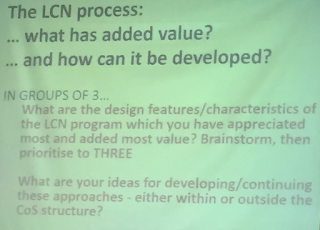Brian Annan summarised this in a final email: Thanks to you all for your openness and collaboration, a true celebration of lateral learning in NZ.
Michael Fletcher's tweet also summed up the engaging two day hui in a nutshell.
Michael Fletcher's tweet also summed up the engaging two day hui in a nutshell.
Brian instructed everyone to take agency and make the most of the two day hui. I loved this comment. It was up to us to be proactive and make it work for ourselves. This works for anything. We can either sit back and complain that something isn't what we expected or we can actively ensure that we find value in it. It's like the half-full glass. This blogpost is a lengthy one basically because there was so much I wanted to record and reflect on from the hui. Here is a summary of the contents of this blogpost: Learning Session - Student Agency through Pathways Learning Session - Learning maps, a new evaluative tool Links to Joanna Robson's blog accounts of nine learning sessions and key notes Further notes to support the excellent learning session - Passion Projects Akoranga o Naenae (AON) Final messages from Valerie Hannon keynote and video by Steve Cutts Final message from Brian Annan. Learning Session - Sustainability the never ending story Where to next for Whitestone Network. Here is the link to the Hui blog networkinghui2015.blogspot.
There are also a range of comments, reflections and photos on the Twitter hash tag #NNH in relation to key notes and seminars. Active Reflections: Learning Session Student Agency through Pathways Maungaraki School, Wellington from the Seaview Network. Janet Evans with students Hannah,Tasneem and Felix. This student-led presentation was one of the highlights of the two days for me. Much of the learning that is happening for these students mirrored the learning approach that we are actioning at our school this year. I loved the way that Janet introduced the presentation and the students, then let the students take the lead. The learning session content offered next steps for us to consider in our senior learning hubs.
Learning Session Learning Maps, a new Evaluative Tool Brian Annan and Mary Wootton Although I am already familiar with learning maps, my respect and regard for these presenters drew me to this learning session. It has made me more determined to make greater use of learning maps as an evaluative tool at school. Their value as a simple yet powerful visual record of learning and achievement can't be overlooked. I shared some information about this on a blog in 2014. Mary explained the meaning of learning maps and Brian explained the value of learning maps Brian and Mary explained that the maps help the learners to articulate change priorities.Brian and Mary responded to questions about learning maps. Brian explained that all learners are capable of creating learning maps. Brian explained what could happen if learning maps become interactive and social.
I was fortunate to see @Joanne Robson in action, live blogging on seminars and workshops that she attended and recording them on her engaging blog empowerednz.blogspot.co.nz. Joanne captured succinctly the essence of learning sessions and published them immediately. This is an awesome skill. Thanks to Joanna, I have provided links to her work below: Building Leadership Capacity and Commitment -Tasman School Nelson, Moutere Hills Network Learning through Different Eyes - Sharlene Carki, Weston, Whitestone Network Oamaru. Sharlene's presentation was based on her work as part of her sabbatical with targeted learners at Weston school. It was very well received. Science isn't just a Subject -Dr Michelle Dickinson (Nanogirl) TELL ME I forget, TEACH ME I may remember, INVOLVE ME and I LEARN Waikowhai Intermediate A collaborative, informal learning session Part One: LCN and Personalised Learning Murrays Bay Intermediate Passion Projects - Akoranga o Naenae - Kelly Layton, Clare and Natasha My additional notes: This presentation was another one of the highlights for me. The fact that three teachers from different schools across their network came together with forty-five targeted learners every Friday over a fifteen week period and focussed on active learning traits was inspiring. Introducing Global Trends - Valerie Hannon Learning Session - Sustainability. The never ending story. I would like to thank Nicky Ryan my fellow presenter for this session. Together we presented a session based on our work as part of the Whitestone Network. It was empowering to present from a network perspective rather than a school only perspective. You can access our notes and links here. One of our tasks was to map out our next steps as a network. We will share our thoughts and ideas with our network and ensure we continue to keep the momentum going and drive forward for the benefit of all learners across our network of schools.
This was an invaluable two days and I sincerely thank the organisers especially Leanne Smith the Sector Co-ordinator who did a stunning job. Finally, an extra special mention of thanks to my daughter Chantelle who is teaching in Melbourne. She flew over for a surprise catch up and joined into the hui. |












Thanks so much for sharing this. I was disappointed not to be there and this has filled in a lot of gaps for me.
ReplyDeleteDorothy
Taking the time to record my experiences has helped me to process so much more of it Dorothy. Thanks for your feedback and glad that this was of value to you.
ReplyDelete